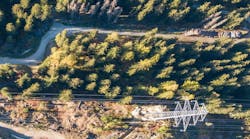With thousands of miles of distribution and transmission lines crisscrossing the United States, the National Wild Turkey Federation (NWTF) saw an opportunity to expand its partnerships with utilities while also providing some benefits to wildlife. The NWTF saw this as a chance to have a positive impact on the millions of acres of rights-of-way (ROW) managed by utilities.
In 2002, the NWTF started the Energy for Wildlife program, which works to create or improve wildlife habitat on ROW and other property owned or controlled by utilities. The program is open to any utility in the energy business (electric, natural gas, gasoline, oil and coal). The NWTF works directly with utilities to improve wildlife habitat throughout the properties it manages by providing several benefits, including technical assistance, regulatory assistance, education and third-party approval of each utility's ROW wildlife management plans.
Utilities as Partners
Through the Energy for Wildlife program, more than 45 utilities have partnered with the NWTF, including electric cooperatives and large investor-owned utilities. Although the partner utilities are different in many ways, they all realize managing vegetation not only supports their utility's goals, including lowering long-term maintenance costs, but also supports conservation throughout their operating areas.
Over the years, wildlife habitat has been the key to promoting viable wildlife populations across the United States. Whether the property is a national forest, state land or 40 acres (16 hectares) in a backyard, creating and improving the habitat will lead to better populations of wildlife. This management can take many forms and includes the use of tools available to create and maintain a diverse landscape to meet the needs of many wildlife species. Federal and state agencies, as well as conservation and other management organizations, have found manual, mechanical, biological, cultural and chemical techniques can be used to create and maintain these habitats.
Developing a complete integrated vegetation management (IVM) program calls for using a wide variety of vegetation management tools, including using the correct herbicide in the right place at the right time. Herbicides are a proven safe and effective method for managing forest vegetation and are appropriate for achieving many objectives, including regeneration establishment, increased timber production, enhanced wildlife habitat, non-native plant control, and road and facility maintenance. When properly applied, herbicides can increase property value, productivity, aesthetics and utility. Many utilities have seen this type of management also can lead to lower maintenance costs, especially when compared with a mechanical-only program.
Impacts to Wildlife
More than 50 years ago, two professors began looking at the management of ROW using herbicides and other techniques, and how they could affect wildlife. In 1953, Dr. William Bramble and Dr. William Byrnes, both professors at Purdue University, formed a partnership with the Pennsylvania Game Commission and others to study vegetation management on an electric transmission ROW and the impact to wildlife. While this research is still ongoing, what has been found is that ROW using herbicides provide more of the habitats needed by both game and non-game wildlife species.
For many years, the NWTF has supported the use of herbicides to help manage timberlands, control invasive plants and improve wildlife habitat. When used correctly, herbicides are an important tool in ROW management to control unwanted vegetation while promoting the more beneficial, low-growing native plant species needed by wildlife for food, nesting and escape cover. These early serial habitats have declined in many parts of the United States because of land use changes over the last century. And, in some states, these grass-forb-shrub areas created by IVM programs make up a large portion of the habitat available for many wildlife species.
Promoting Wildlife
Central Vermont Public Service (CVPS) has been a longtime supporter of the NWTF, working to promote wildlife habitats. With the requirements from the Public Service Board in Vermont, CVPS has put together a wide-ranging plan of the management of its ROW system, the use of IVM and how it is a benefit to its customers, landowners, the public and wildlife.
From CVPS's many years of implementing an IVM program, the utility has promoted much-needed grass-forb-shrub habitat in the Northeast for wildlife species such as wild turkeys and golden-wing warblers. Even more interesting, CVPS has been able to provide these benefits while reducing the amount of herbicides used in its IVM program, and it still costs the utility less than implementing a complete mechanical-clearing program.
Even smaller electric cooperatives have seen the benefits of having a partnership with the NWTF. Many of these utilities have asked for help with putting together a plan for their vegetation management programs and also how they can build better support from their customers, landowners and the public.
South Central Indiana Rural Electric Membership Cooperative (SCI REMC) began working with the NWTF in 2003 and quickly began improving its vegetation management program in the Martinsville, Indiana, service area. As one of the first utilities certified by the NWTF's Energy for Wildlife program and the first recipient of the NWTF's national achievement award for utilities, SCI REMC saw it needed support to fully implement a vegetation program.
SCI REMC developed an outreach plan for Earth Day events that highlighted the benefits of its management to various groups in the Martinsville territory. So far, the co-op has installed 432 bluebird boxes, 116 bat boxes, 81 owl boxes, 18 flying squirrel boxes, nine hawk platforms, seven raptor perches, three eagle platforms — each more than 60 ft (18 m) tall — and dozens of wildlife food plots. These efforts have enabled SCI REMC to fully implement its IVM program on ROW and have become a positive example for wildlife conservation in the energy industry.
These existing corridors, as well as new ones being constructed, will continue to bring out strong feelings from people on all sides. By working with utilities and others, NWTF sees great opportunities to restore and manage these corridors for multiple benefits. And who would not like the chance to help control energy costs while also having a positive impact on wildlife?
Jay Jordan is the Energy for Wildlife coordinator for the National Wild Turkey Federation.

